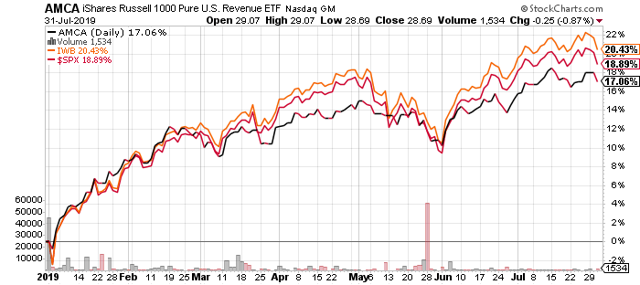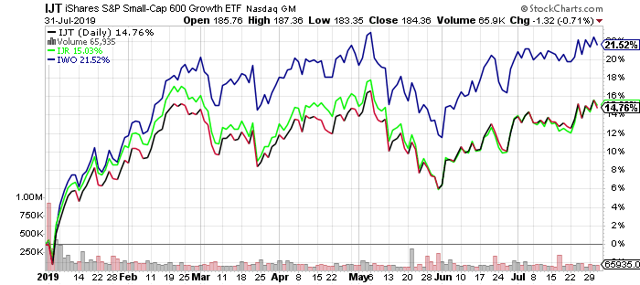[ad_1]

(Pic Sourced Here)
Investors are knee-deep in earnings season and once again we’re here to tell you that if you’re not reading FactSet’s amazing Earnings Insight Report on the S&P 500 (Click Here (pdf)), you’re doing yourself a serious disservice. Their weekly updates can offer a tremendous amount of actionable insights for investors, but the one we found most compelling in the most recent issue had to do with growth in international sales and earnings, or specifically the lack thereof.
It’s been a very prevalent theme both FactSet and S&P have been focusing on in 2019, that companies within the S&P 500 that derive more than 50% of their revenue from international markets have seen their top- and bottom-line growth rates turn negative, weighing down the broader index and potentially putting your portfolio at risk. Consider this quote from the 7.26 edition of the Earnings Insight Report:
“The blended (combines actual results for companies that have reported and estimated results for companies yet to report) earnings decline for the S&P 500 for Q2 2019 is -2.6%. For companies that generate more than 50% of sales inside the U.S., the blended earnings growth rate is 3.2%. For companies that generate less than 50% of sales inside the U.S., the blended earnings decline is -13.6%.
The blended revenue growth rate for the S&P 500 for Q2 2019 is 4.0%. For companies that generate more than 50% of sales inside the U.S., the blended revenue growth rate is 6.4%. For companies that generate less than 50% of sales inside the U.S., the blended revenue decline is -2.4%.”
Source: FactSet Earnings Insight Report – updated 7.26.19
Now, let’s face it, American investors haven’t exactly been shy about avoiding international exposure in their portfolios over the last decade, and with good reason, namely consistent underperformance. In fact, it’s gotten to the point where Morningstar sent out a research update called “Should You Bother Investing Abroad?” So it’s no wonder that investors have put their faith almost exclusively in the domestic indices like the S&P 500, which has more ETF assets linked to it than any other large-cap benchmark. But just how safe is your domestic portfolio from international upsets like trade wars, tariffs, a stronger dollar, and even just cyclical weakness. And how can you reduce that risk going forward?
To answer that, we first have to ask how much of the revenue of the S&P 500 (the large-cap benchmark with the most client assets in the ETF world) comes from outside the U.S., and then what sort of investment options there are for investors looking to eliminate foreign sales risk even from their domestic holdings.
Angels on a Pin
Of course, trying to estimate the S&P 500’s percentage of global sales is easier said than done given that not every S&P 500 component actually provides this information which requires a lot of approximation, estimation, and just good old detective work that we didn’t feel like doing. In fact, the amount of effort required to do it is so onerous that even S&P itself only provides an updated estimate on an annual basis with a substantial time lag. Their most recent report covers the period ending 12.31.17 and was only published in August of 2018. You can read more about it here, but the most often cited value in different reports showing the estimated sales from outside the U.S. is 43.6% of the total revenue of the S&P 500, although that required some serious guesswork. Actual foreign sales appeared to be only 27% of reported revenue, but the team at S&P was then forced to work through companies that reported no foreign sales because they’re domiciled in the U.S., even though they have foreign plants and operations and make adjustments to arrive at that estimate of 43.6%. They’ve used a consistent process over the years, but again, it’s an adjustment.
A second report we’ve found after scouring the web for some recent analysis was this February 2018 post from Phillip Brzenk on the Indexology Blog website called, How Global Are the S&P 500, the S&P MidCap 400, and the S&P SmallCap 600 Style Indices? However, his approach seems to use a different dataset from FactSet rather than using S&P’s internal analysis which was fine because it provides data on the other segments of the S&P 1500 index. He cites that over 70.9% of the S&P 500’s revenue came from the U.S. in 2017 versus the 57.4% listed by Howard Silverblatt in his analysis and perhaps that’s close enough for our purposes.
Using either estimate leads you to one inescapable conclusion, there is a lot of foreign exposure in a supposedly domestic index which begs the question, how does a pure “American Only” strategy perform? Fortunately, there’s an ETF for that.
America the Beautiful in Just One Fund
Those investors who like the idea of cutting out the international exposure even in their domestic funds but don’t feel like doing some heavy analysis can take heart because someone has already gone to the trouble of building an ETF that does just that, although don’t be surprised if the reality is less than the promise.
The fund in question is the iShares Russell 1000 Pure U.S. Revenue ETF (AMCA) which debuted in August of 2017 and, as the name implies, offers exposure to those Russell components who can claim to have most of their revenue derived from within the good old U.S. of A. The fund’s benchmark, maintained by FTSE Russell, is straightforward with Russell taking its large-cap universe and scrubbing it using data provided by the components to calculate their “domestic sales ratio” or DSR. Then once a year in September, they’ll sort their universe and look for those constituents with the highest domestic sales with new entrants into AMCA needing a DSR above 90 while existing holdings need a score of at least 85 to remain in the fund.
The index components are then weighted by market cap, although there is a firm cap in place so no holding can be more than 5% of the portfolio and no industry (here using FTSE Russell’s own ICB system) is more than 33% of the fund. That’s easy enough to understand, but given the globalization of the last several decades, exactly what sort of portfolio does the investment process give you? A surprisingly large one with currently over 400 holdings, although with significant differences compared to the Russell 1000.
First, there’s the average market capitalization with the fund having a slightly “smaller” feel to it than the Russell 1000 or S&P 500 despite having more of its portfolio concentrated in its top ten holdings. What do we mean by a slightly smaller feel? Well, despite being plotted into the large-cap value category by Morningstar, AMCA has substantial positions in many smaller and mid-cap stocks. In fact, as of 7.29, AMCA had just over 28% of its portfolio in its top ten holdings, more than the Russell 1000 or S&P 500, but thanks to the fact that smaller-cap stocks are typically more focused on domestic markets and that it has a concentrated portfolio off 400 names, AMCA has a lower average market cap than either of its large-cap core peers.
Second, there’s a substantially different sector make-up than you would find with the Russell 1000 or S&P 500, with AMCA substantially underweighting technology stocks at 4.1% of its allocation compared to 21.8% of the Russell 1000 in favor of utilities (11.21% to 3.2%), financials (24% to 13%) and communications (11.9% to 9.7%), respectively. And by communications, we mean AT&T (NYSE:T) and Verizon (NYSE:VZ), both of which have weights above 3% in AMCA versus the Russell 1000 where neither is about 1%. So prepare yourself for a value-oriented portfolio short of high-growth tech stocks.
How did AMCA wind up in this position? Not surprisingly, fixing a domestic revenue requirement at 85% to 90% draws a portfolio that could best be described as “Only American” versus “America First” because most of the companies that can meet it are those who absolutely dominate a region or even industry, but only within the U.S. So utilities, telecoms, railroads, large banks and even retailers (Dollar General (NYSE:DG) anyone?) are the only big companies that meet that revenue target. That leaves the portfolio firmly in the large-value bucket and has held it back against a market obsessed with growth stocks. Unfortunately for the idea of “Only American Investing,” AMCA has slightly underperformed the iShares Russell 1000 ETF (IWB) in 2019, returning just over 17% through July 31 compared to 20.43% for IWB and 18.89% for the S&P 500, extending a run of weaker performance that dates back to the fund’s inception.

If you’re wondering why the performance isn’t worse, FactSet’s report points out that technology stocks have been weighing on the broader markets’ earnings this quarter, so being light on tech hasn’t been as much of a handicap.
Small Caps = More American?
We’ll discuss other ways to invest in more “American” companies later on, but what about that traditional bit of investment logic that says investors who want more U.S. exposure should stick with small-cap names? Our business school textbooks may have claimed that small-cap stocks traditionally had a more exclusive focus on selling only within domestic markets, but a more recent update was that February 2018 post from Phillip Brzenk on the Indexology Blog website that we mentioned earlier. Brzenk actually breaks down every style box for us using the S&P 1500 components and finds that the most “American” of the boxes is none other than the small-cap growth box, with more than 80% of its revenue in 2017 derived from the United States versus a mere 65% for the S&P 500 Growth (or the large-cap growth box) components. But how has a representative fund performed so far in 2019 when the market has seemingly punished stocks with more international exposure?
Small cap stocks have struggled in 2019 as recession fears have led investors to favor large cap stocks, although the small-cap growth funds have done better depending on which index they’re benchmarked against. The iShares S&P Small-Cap 600 Growth ETF (IJT) is up a mere 14.8% YTD compared to 15% for the small-cap core equivalent fund, iShares Core S&P Small-Cap ETF (NYSEARCA:IJR), while its Russell 2000 growth counterparts (here using the iShares Russell 2000 Growth ETF (NYSEARCA:IWO)) are up over 20%. The primary difference between them remains profitability as the S&P 600 requires positive TTM earnings while the Russell 2000 isn’t that selective. That could explain why the Russell 2000 Growth Index has almost twice the exposure to small biotech stocks as the S&P 600.

So if you do want small-growth funds that offer more “American” exposure, you’ll be forced to make a decision as to what other risk factors you’ll be adding in the process. The Russell 2000 Growth Index will have more “aggressive” growth names given that it will include newer companies that are unprofitable versus the S&P 600 where companies without earnings need not apply.
A Better Way to Support America
So what’s a patriotic, or at least profit-oriented investor to do if a fund like AMCA isn’t quite up to the task? Fortunately, the explosive growth in the ETF industry means there are multiple products/strategies to choose from, although potential users should remember the old adage “let the buyer beware.” None are as explicitly labelled as AMCA or offer as clean a strategy, forcing potential users to do some serious homework before adding the funds to their portfolios.
First, you need to ask yourself what sort of “America First” strategy you’re looking to embrace? If your focus is on patriotism rather than profits, you might want to check out one fund we profiled last year, the Pacer Military Times Best Employers ETF (VETS), which builds a portfolio around companies recognized for their efforts to hire veterans. You can read more about it here, but investors who believe that buying an “ESG” fund means sacrificing gains for beliefs should take heart from VETS’s strong performance in 2019 despite having a large-core portfolio with a strong infusion of value stocks. VETS was up over 27% YTD through July 30th, outperforming other funds in the large-core space along with the Russell 1000 index, although it does carry a .6% expense ratio compared to .15% for IWB.
What’s driving those returns? Unlike AMCA, VETS has a healthy dose of tech exposure, although it is underweight the sector compared to other large core funds or the Russell 1000 index, but the tech stocks it does own are strong performers like CDW Corp. (CDW) and Leidos (LDOS) where 22% of employees are veterans according to the most recent data from the Military Times which publishes the employer survey that helps build VETS’s portfolio. And thanks to an equally weighted allocation, smaller stocks like CDW carry more heft in the portfolio than a mega-cap stock like Amazon (NASDAQ:AMZN), which is also in the mix because of its hiring practices.
Conclusion:
Whether weak earnings persist for companies that rely on their international operations is far from certain, but investors do have numerous ETF options on how to manage that potential risk, although be careful about what kind of protection you’re buying. Embracing “America First” could leave you with a portfolio full of cyclical stocks that may dominate their field, but in the end, you could be stuck with a value bent having traded one unintentional exposure for another.
Disclosure: I/we have no positions in any stocks mentioned, and no plans to initiate any positions within the next 72 hours. I wrote this article myself, and it expresses my own opinions. I am not receiving compensation for it (other than from Seeking Alpha). I have no business relationship with any company whose stock is mentioned in this article.
Additional disclosure: Assumptions, opinions and estimates constitute our judgment as of the date of this material and are subject to change without notice. ETF Global LLC (“ETFG”) and its affiliates and any third-party providers, as well as their directors, officers, shareholders, employees or agents (collectively ETFG Parties) do not guarantee the accuracy, completeness, adequacy or timeliness of any information, including ratings and rankings and are not responsible for errors and omissions or for the results obtained from the use of such information and ETFG Parties shall have no liability for any errors, omissions, or interruptions therein, regardless of the cause, or for the results obtained from the use of such information. ETFG PARTIES DISCLAIM ANY AND ALL EXPRESS OR IMPLIED WARRANTIES, INCLUDING, BUT NOT LIMITED TO ANY WARRANTIES OF MERCHANTABILITY, SUITABILITY OR FITNESS FOR A PARTICULAR PURPOSE OR USE. In no event shall ETFG Parties be liable to any party for any direct, indirect, incidental, exemplary, compensatory, punitive, special or consequential damages, costs, expenses, legal fees, or losses (including, without limitation, lost income or lost profits and opportunity costs) in connection with any use of the information contained in this document even if advised of the possibility of such damages.
ETFG ratings and rankings are statements of opinion as of the date they are expressed and not statements of fact or recommendations to purchase, hold, or sell any securities or to make any investment decisions. ETFG ratings and rankings should not be relied on when making any investment or other business decision. ETFG’s opinions and analyses do not address the suitability of any security. ETFG does not act as a fiduciary or an investment advisor. While ETFG has obtained information from sources they believe to be reliable, ETFG does not perform an audit or undertake any duty of due diligence or independent verification of any information it receives.
This material is not intended as an offer or solicitation for the purchase or sale of any security or other financial instrument. Securities, financial instruments or strategies mentioned herein may not be suitable for all investors. Any opinions expressed herein are given in good faith, are subject to change without notice, and are only correct as of the stated date of their issue. Prices, values, or income from any securities or investments mentioned in this report may fall against the interests of the investor and the investor may get back less than the amount invested. Where an investment is described as being likely to yield income, please note that the amount of income that the investor will receive from such an investment may fluctuate. Where an investment or security is denominated in a different currency to the investor’s currency of reference, changes in rates of exchange may have an adverse effect on the value, price or income of or from that investment to the investor.
[ad_2]
Source link Google News

